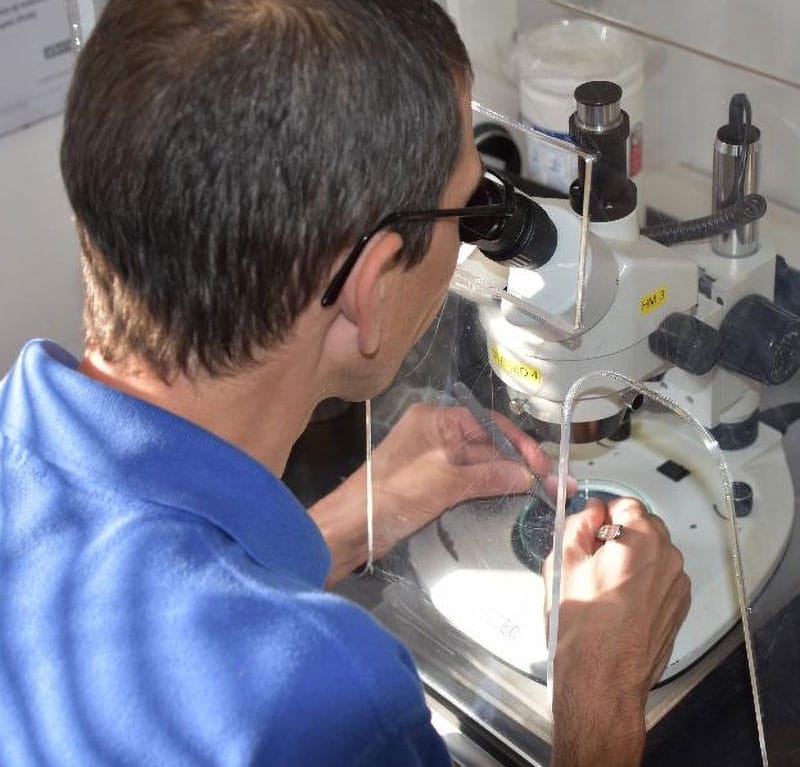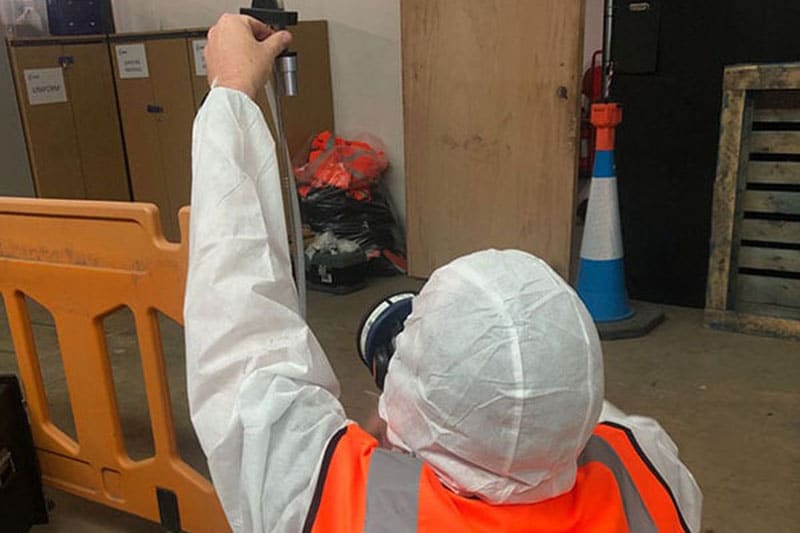How accurate is asbestos air testing and monitoring?
Below, then, we have sought to take a closer look at the factors that impact upon the accuracy of asbestos air testing and monitoring, and the related things you need to know.

Courtesy of Asbestos Laboratory Services (UK) Ltd
Importance of accuracy in asbestos air testing
One reason why accurate asbestos air testing is so important, is simply the legal obligation for such information to be recorded. Regulation 19 of the UK’s Control of Asbestos Regulations 2012 (CAR 2012) stipulates that employers must arrange the regular monitoring of asbestos fibres, alongside keeping records of the results.
However, there is also the practical reality that when airborne asbestos fibres are accurately measured, this can greatly help employers to take measures that achieve legal compliance, at the same time as keeping users of the given space safe.
CAR 2012, Regulation 2, specifies a control limit of 0.1 fibres per cubic centimetre (f/cm3). This should not be interpreted as a definitive guiding line between a “safe” and “unsafe” concentration of asbestos fibres in the air. If, however, an accurate asbestos air test finds the level in a particular area to be below this figure, this would be typically considered “reasonably safe”.
In circumstances where the aforementioned control limit is or is likely to be exceeded, Regulation 11(2) of CAR 2012 sets out that the employer must provide suitable respiratory protective equipment (RPE) if there is no other means by which exposure levels can be reduced.
The use of all types of asbestos has been banned in the UK since 1999, and to this day, the World Health Organization (WHO) classifies all types of this mineral as Class 1 carcinogens. Inhalation or ingestion of the substance is associated with a heightened risk of developing certain frequently fatal health conditions, such as mesothelioma and asbestos-related lung cancer, in later life.
Exposure to this lethal substance should be prevented, but where this is not possible, exposure should be kept as low as practicable at all times. At minimum, you will need to lower the level of asbestos exposure to below the asbestos control limit.
So, you can probably begin to see why it is so crucial to ensure any asbestos air test that you arrange gives an accurate result, as this could have very real practical, legal, and health implications.
Factors affecting accuracy in asbestos air testing
There are various factors that can impact on the accuracy of the results that your asbestos air test produces. These can include the exact sampling and analysis methods used, as well as the sophistication of the equipment used, and – in mixed-dust situations – the presence of non-asbestos fibres and particles.
The Health and Safety Executive (HSE)’s guidelines document entitled Asbestos: The Analysts’ Guide – with the series code HSG248 – states within a section dedicated to the sampling and evaluation of fibres by phase contrast microscopy (PCM), that “the true fibre concentration of a given dust cloud cannot be measured with absolute accuracy or certainty.”
We have previously written about the importance of this HSE publication for asbestos analysts, and it can be downloaded for free from the HSE website.
Sampling methodology
With there being various reasons why an employer might request asbestos air testing and monitoring at their site, some people may easily become confused between the different sampling methods available. So, here are some key distinctions to know about:
Personal vs area sampling
Some forms of asbestos air monitoring – such as asbestos leakage testing or asbestos background testing – focus on the concentration of asbestos fibres in a specific area.
Asbestos personal air monitoring, however – also often referred to as “personal sampling” – is designed to test the air that immediately surrounds a given person. This helps to ascertain the level of asbestos fibres that an equipment wearer may be breathing in.
Static vs dynamic sampling
Personal sampling is a form of dynamic sampling. It accounts for the reality that a person working in a given area may move around that space, and the exact concentrations of asbestos fibres in the air (and therefore the risks posed) may fluctuate as a consequence.
By contrast, static sampling assesses the levels of airborne asbestos fibres in a single “static” location, such as a specific room of a building known or suspected to contain asbestos.
The specific sampling strategy followed in a particular case – encompassing elements like the placement and number of samples, and the duration of sampling periods – could have major implications for the accuracy of the results produced.
Equipment and calibration
The basic process of asbestos air testing is as follows: a sample is captured of the air (whether in a specific fixed location or close to a person), and this sample then undergoes microscopic analysis for the purposes of counting the fibres.
Such a specialised process is only possible with specialised equipment. This encompasses such essentials as air sampling pumps – used to draw the air through a filter – and sampling cassettes and filters.
As we referenced in our more in-depth article on asbestos air testing equipment, the types of filters used in asbestos sampling include mixed cellulose ester (MCE) filters (a common choice for PCM analysis) and polycarbonate filters (the favoured choice for TEM analysis).
The proper calibration of such equipment will be imperative to efforts to ensure the greatest possible accuracy from asbestos sampling. Regular calibration schedules and procedures will need to be followed, supported by suitable records.
Laboratory analysis techniques
The analysis techniques followed for asbestos air testing and monitoring have their own sizeable impact on the accuracy of the results. Below is a summary of commonly used methods:
Phase contrast microscopy (PCM)
This is the standard method used for the sampling and counting of airborne fibres – although it does have a major drawback of being unable to distinguish between asbestos fibres and other, non-asbestos fibres. This is because PCM focuses not on the chemical composition of the fibres under analysis, but instead the morphology of those fibres (their form and structure).
This, in turn, has major implications for the accuracy of the results you can depend on PCM providing, particularly in situations where there are likely to be only low concentrations of asbestos in the air. In such scenarios, a significant proportion of the counted fibres will almost certainly not be asbestos fibres, even if their shape and size are akin to asbestos.
Transmission electron microscopy (TEM)
While PCM has its advantages as an analytical method – including its speed and cost-effectiveness – if you desire more accurate results and are willing to pay more and wait longer for them, TEM could be an excellent alternative.
TEM is able to magnify fibres up to 20,000 times or more. Furthermore, it allows for analysis of not only the morphology of the captured fibres, but also their crystalline structure and elemental composition, in order to identify whether those fibres are asbestos.
Scanning electron microscopy (SEM)
As their respective names imply, SEM and TEM are both types of electron microscopy, which entails electron beams being focused on microscopic amounts of materials to analyse them.
SEM is more affordable and less labour-intensive than TEM, but it has historically been regarded as less accurate than TEM. While, for instance, the electrons used with TEM pass through the sample – thereby allowing for far superior spatial resolution – in the case of SEM, the electrons are reflected off the surface.
However, as researchers have discovered, considerable advances have been made in recent years in SEM technology’s imaging power and other capabilities. So, SEM appears to be gaining in reputation all the time, particularly when it is borne in mind that TEM must still be done in a laboratory, whereas the emergence of tabletop SEMs allows the latter tech’s use “in the field”.
Alongside the specific analysis method used, asbestos analysts must also consider the impact that sample preparation can have on accuracy. So, it is of the utmost importance that they always follow proper handling and preparation techniques.
Precision and accuracy in asbestos testing
Confusion can sometimes arise with regard to the distinction between precision and accuracy when testing and monitoring procedures are carried out. This is another subject addressed in greater detail in the HSG248 guidance document.
Nonetheless, the differences can be broadly summed up as follows:
Precision
In this context, precision can be defined as the consistency of the asbestos air monitoring results across multiple tests.
The number of fibres counted, as well as the uniformity of the fibre distribution on the filter, will make a big difference to the level of fibre counting precision that can be achieved.
Accuracy
Accuracy, on the other hand, refers to how close the recorded results are to the true value (in other words, the actual concentration of asbestos fibres in the air).
As we have referenced, multiple factors can impact on the accuracy achieved, including the level of non-asbestos fibres present in the air, as well as the analysts and laboratories used, which may produce results that very significantly from each other. Proper training and periodic quality checks will be crucial for controlling such intra-laboratory and inter-laboratory variations.
With both sampling variability and analytical variability inevitably impacting upon the precision and accuracy that can be achieved from asbestos air testing, measures will need to be put in place to combat this. Such steps could include the greater standardisation of procedures, as well as the implementation of rigorous quality assurance programs.
Reporting and interpretation of results
Unfortunately, if there are issues with accuracy at earlier stages of the asbestos air testing and monitoring process, this will have a knock-on impact on the results produced – and therefore how those results will need to be reported on and interpreted.
So, every possible step should be taken to ensure clear and accurate reporting, including the transparent discussion of potential errors and uncertainties.
With inaccurate results having potentially serious regulatory and health and safety implications, the subject of accuracy must be treated with the greatest seriousness at every stage, including in the reporting of results.
Conclusion: accuracy will always be of critical importance for asbestos air testing
As we have set out in this piece, achieving the most accurate possible information from asbestos air testing and monitoring is hugely important – for reasons of health and safety, as well as legal compliance.
By adhering to both regulatory standards and industry-accepted best practices, asbestos analysts and employers can help ensure the most consistently accurate results.
To learn more about our accredited asbestos services including asbestos air testing and monitoring, and to request a quote, please contact the Oracle Solutions team today.

Written by Mark Carter
Mark Carter is a renowned expert in asbestos management, offering clients vital guidance on compliance and safety. His expertise is invaluable for navigating asbestos regulations, ensuring both safety and legal adherence. Mark's role is central in providing effective asbestos-related solutions, helping clients achieve their business objectives with an emphasis on regulatory compliance and safety in asbestos management.

